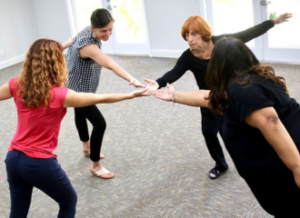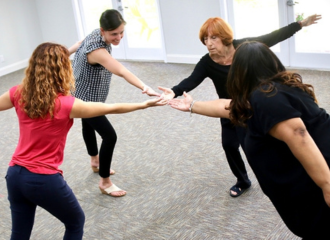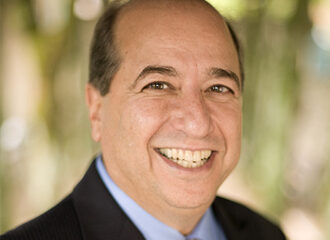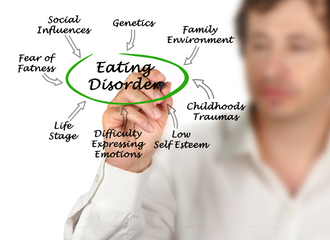Written by: Sara Earl, MS, NCC, R-DMT
PRN Group Therapist
Registered Dance/Movement Therapist
Dance and movement therapy can bring real benefits to the eating disorder treatment and recovery process. But if you’ve never been the dancing type, here’s why you should reappraise.
“Darling, never be too shy to dance your heart out.” – Audrey Hepburn

The forces that have shaped our body image and convinced us that we “can’t” dance are overlapping. People with eating disorders are often afraid to be seen and take up space for fear that they will not measure up to an imagined ideal. I propose it’s not that we can’t dance, it’s that we are afraid to.
Reappraising is asking: Is there any possibility that my automatic thought is not true? Let’s consider if “I can’t dance” might not be true. Is there any possibility that overcoming the fear of dance may yield rewards for your self-esteem, mood and quality of life? The evidence certainly supports these outcomes (Koch et al., 2019). If you answered yes, here are some deeper ideas to consider…
Maybe you can
Dance generally refers to moving the body in synchronized or rhythmic ways to express a feeling or idea. It can be performative or participatory. The latter is the context in which most people say they “can’t dance”: the spontaneous social freestyle of the high school prom, wedding reception or “going out” dancing.
If you don’t dance, why not? Do you remember when you loved to dance? (You may have to go way back.) When did that change for you? What societal values might you have internalized that are denying you the unbridled freedom to move and groove?
People have been dancing to communicate, celebrate and connect as far back as we can imagine. We suspect our Neanderthal ancestors danced but the first surviving evidence dates back 9,000 years. Every culture across time has had its own dance tradition. We are born with the ability to recognize rhythm and can move with it as young as six months old. With an activity this fundamental to humanity, why are we all so shy about dancing?
The same mid twentieth century movement that gave birth to modern dance gave rise to dance/movement therapy (DMT). Modern dancers introduced the idea that dance could be self-expressive in contrast to classical ballet’s rigid technique. Early DMT therapists were modern dancers who felt that a similar concept could help those in mental anguish. You might say that addressing the buried emotions and rigidity that accompany an eating disorder is in the DMT DNA.
Recent trends in psychiatry have promoted the therapeutic benefits of rhythm and resourcing and processing through the body. And yet, ever since Freud invented the “talking cure”, therapy still predominantly looks like sitting and talking. DMT therapists promote the full range of the body’s potential for movement. Confident freestyle social dancing is a goal. The following is what the process looks like, including suggestions for how you might get started on your own.
Bodyfulness
Bodyfulness is mindfulness with an emphasis on connecting to the body. The first step is to develop a more intimate relationship with your body. You should plan on spending some quality time alone together. Enlist a trained support person if the prospect feels overwhelming. (A DMT therapist is ideal!)
Start by simply tuning into your body more and more often. Think of it as a dynamic three-point check: What is my body saying now? And now? And now? At any moment there are an infinite number of somatic cues asking to be noticed; for example, the temperature, the sequential firing of muscles in a kinetic chain, even the nuanced neurochemistry of your emotional state. Get curious and study your body’s owner’s manual to sense your function from the inside-out. This moment-to-moment subjective experience in your body (AKA embodiment) can challenge a negative body image with the by-product of body respect.
Holistic Flexibility
At about the same time that DMT was emerging, psychiatrist Paul Shilder (1950) theorized that we can shift our thinking by moving. Considering how Shilder’s argument relates to cognitive flexibility, a holistic form of flexibility might include exploring whole-body movement as a way to promote flexible thinking.
As we move nonverbally, we see things in our minds eye; memories bubble up, and there is a constant filmstrip of salient insight. The body in motion offers up what the subconscious is holding without the pressure of having to form words.
Dancing is also inherently inclusive and adaptive. One can move quite softly and subtly and still be dancing. For those who struggle with compulsive exercise, dancing can be a way to rebalance exertion with joy. Dance can be uniquely joyful! The moving equivalent of intuitive eating is partaking of this joy while still respecting the body’s signals of fatigue or pain to know when to rest.
Try this: begin with a simple rhythmic move and change it every-so-many beats. Acknowledge the judgement that comes up and keep going anyway. If you find a move that feels good, stay with it. If it becomes boring or unpleasant, change it! Move past your habits and judgements and allow the creative spirit to take over.
Emotion in Motion
The change theory of DMT is that we can access and transform repressed emotion through movement. Dancing is another way to lean into the emotions that you avoid. We express our emotions subconsciously through movement all the time—from the rate of the breath, to our facial expressions, the gestures we make as we talk, and the way we stand and walk. Freestyle dancing is just the next step.
Beyond containing your exuberance to prevent injury, there are no rules. Pick a song that reflects your mood, invoke your bodyfulness and the creative spirit, and just start dancing. Make the melody visible, act out the lyrics or be as gawky as possible on purpose. See if you can capture any thoughts that come up by journalling or drawing. Notice if your mood has shifted. It is impossible to know ahead of time what you will experience but almost certainly you will be moved.
Dancing to Connect
If you have decided that you actually might be able to dance, from line dance meetups to adult-beginner technique classes to free-spirited conscious/ecstatic dance tribes, there are bountiful opportunities to do so with others. (I recommend dancing with other bodies in a shared space, if possible, rather than on TikTok or Zoom.) We know that eating disorders are isolating and dancing together is a great way to connect and build life-affirming community.
When you allow yourself to be seen dancing, moving authentically as you, you give permission to those around you to do the same. And this dancing contagion can be revolutionary.
As we learn in The Renfrew Center Unified Treatment Model ™, the prescription for the life-diminishing effects of avoidance is choosing an “alternative action”. We slowly and incrementally face our fears in order to grow beyond them. If you fear moving and expressing yourself creatively in your body—consider that the imperative is precisely that.
Shall we dance?
References
- Koch, S.C., Riege, R.F.F., Tisborn, K., Biondo, J., Martin, L., & Beelmann, A. (2019). Effects of dance movement therapy and dance on health-related psychological outcomes: A meta-analysis update. Frontiers in Psychology. Vol. 10. https://doi.org/10.3389/fpsyg.2019.01806
- Schilder, P. (1950) The image and appearance of the human body. New York: International Universities Press.



